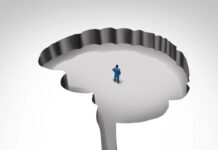Although there is no clinical consensus on the efficacy and therapeutic benefits of eye movement desensitization and reprocessing (EMDR), international mental health humanitarian aid organizations specializing in the therapy are benefitting from and profiting off of its implementation in the Global South.
In a new article, American authors Lorien S. Jordan, Desiree M. Seponski, Amber Kelly, and Nea Kpro explain how EDMR was pushed as a mental health intervention in Cambodia and how this case is indicative of the unchecked globalization of mental healthcare via humanitarian aid.
“The global expansion of mental health through humanitarian aid is a political act associated with conflicts between international organizations, local governance, and the clinicians and clients in the targeted country,” the researchers write.
“International aid organizations assert power over resource-poor countries in making decisions about who can practice clinical services, who can receive these services, and what types of services are delivered. Similarly, the therapies promoted through aid organizations can be influenced by people who have developed and who seek to advance particular forms and modalities of therapeutic practice. Such top-down approaches occur when organizations act in lieu of governance rather than with it. Tensions at the local level arise as concerns over what treatment is most needed and whose culture is privileged are juxtaposed to a backdrop of low funding and a desire for mental health.”
 EMDR therapy is used most frequently with individuals who experience symptoms typically associated with post-traumatic stress disorder (PTSD). Put simply, the EMDR process begins by bringing the traumatic memories that cause and contribute to PTSD, stored in the long-term memory, to the short-term, working memory by thinking about the trauma. Then, while recalling the trauma, an EMDR therapist will then stimulate rapid back-and-forth eye movement with LED lights, their finger, or another object. This rapid eye movement, in tandem with the recollection of the past trauma, is meant to catalyze a multi-layered process of desensitizing, processing, and healing for the individual.
EMDR therapy is used most frequently with individuals who experience symptoms typically associated with post-traumatic stress disorder (PTSD). Put simply, the EMDR process begins by bringing the traumatic memories that cause and contribute to PTSD, stored in the long-term memory, to the short-term, working memory by thinking about the trauma. Then, while recalling the trauma, an EMDR therapist will then stimulate rapid back-and-forth eye movement with LED lights, their finger, or another object. This rapid eye movement, in tandem with the recollection of the past trauma, is meant to catalyze a multi-layered process of desensitizing, processing, and healing for the individual.
EMDR’s humanitarian post-traumatic event use began in 1995, domestically in Oklahoma City. After the bombing of a federal building, EMDR therapists sought to alleviate the trauma via EMDR for the communities that were harmed. This incident led to the creation of the EMDR Humanitarian Assistance Program (EMDR HAP). Over time, EMDR HAP grew its reach internationally, especially in Southeast Asia.
Each of the authors have lived in Cambodia for a prolonged period of time and noticed the prevalence of EMDR across the nation. Central to their paper is the belief that in order for EMDR to be justifiably present, trauma must also be present. However, each of the authors are skeptical that Cambodia is ‘traumatized’ in the way that the Global North believes.
“Cambodia entered the landscape of humanitarian aid recipients most prominently due to the Khmer Rouge autogenocide (1975–1979) that resulted in the loss of approximately 1.8 million lives through mass killings, starvation, and severe torture. Thus, Cambodians are presumed to be inherently at a high risk of trauma, anxiety, depression, and PTSD exceeding the ‘normal’ range,” the authors explain.
“While Cambodians express that socioeconomic factors pose the biggest challenge to wellbeing due to pervasive rates of poverty, expatriate practitioners have suggested that the experiences of the Khmer Rouge created a ‘culture of silence’ that thwarted Cambodians’ natural expression of painful memories, maintaining past trauma into the present day.”
With that in mind, the authors frame their research purpose not as being critical of EMDR or even humanitarian aid, but specifically mental health humanitarian aid. They asked the question: “How do Cambodian psychologists, teachers, and supervisors experience the political landscape of EMDR as a humanitarian mental health program? to better understand in the benefits and drawbacks of mental health humanitarian aid on an international scale.
They begin first by conducting a response evaluation of EMDR in Cambodia. This evaluation was done via an array of qualitative methodologies: interviewing and engaging with stakeholders from across the country, holding and conducting focus groups with marginalized communities, and taking comprehensive field notes and surveys. After collection, the data was then coded multiple times by each author. By the end of the coding process, different themes and tensions emerged.
The authors note that through their research, “…it became clear that the political context surrounding EMDR directly impacted the implementation and acceptance of modalities in Cambodia.”
Indeed, EMDR is considered one of the best practices of therapy in Cambodia, although many Cambodians question why. The participants in the study describe needing to balance meeting the requirements of international funding bodies and project managers as well as simultaneously obtaining the needed education and therapeutic treatments. The authors articulate these complexities in two ways:
-
The foreign push
Cambodians know that EMDR is not a Cambodian invention. Indeed, most participants noted that they felt concerned that the therapy was being pushed, not for their benefit but for the benefit of the international humanitarian aid group, calling EMDR projects “foreigners pushing their pet projects.” Unfortunately, if Cambodian practitioners or patients have critiques, foreign practitioners rarely take the feedback seriously or the criticism well. Each Cambodian participant asked the following in one way or another:
“Does that mean something to Cambodian people, or does that mean something to EMDR?”
-
Caught in-between EMDR associations.
“Throughout the interviews, participants shared the tensions felt regarding the international political push for EMDR, which was magnified by the disconnection between the EMDR Institute and EMDR International Association (EMDRIA).”
Indeed, the tension between the two humanitarian organizations calls into question their legitimacy. Participants noted that the politics between the two organizations frequently getting in the way of doing meaningful work—highlighting that despite good intentions, humanitarian aid organizations have their own political agendas that spill into the day-to-day life of the communities they are ostensibly serving.
The authors leave us with this:
“The global mental health movement promotes the dependence of LMICs on foreign diagnoses for understanding distress and, thus, foreign aid and practices to promote healing. The cycle of distress, diagnosis, and aid furthers the colonization of LMICs, as the medical movement spreads with the globalization of mental health, often at the expense of considering the impacts and complexities of social inequalities that affect the human condition and the problems that mental healthcare attempts to solve.
The conceptualization of what encapsulates a mental health issue as well as a health concern is not singular in nature but is dependent on social and local concepts. When interventions are blindly adopted from one culture to another, we risk neglecting the unique problem-solving and coping skills of the community. Attempts to intervene can devalue the cultural knowledge and resources of a population and impede the normal processing of events that occur. This engages a system whereby distress is medicalized and pathologized without attempting to uncover how such distress might be growth-inducing, healing, and community-building.
As seen in the case study of Cambodia, EMDR, and humanitarian aid, global mental health movements are pushing ideas of PTSD and trauma while simultaneously pushing the application of EMDR. For the country to truly heal from its history of colonization and autogenocide, it must be supported in developing and studying therapies specific to Cambodia. Aid organizations can support these efforts through assisting in training, developing, and evaluating multiple modalities and their ability to culturally respond to social problems.”
Unfortunately, this is nothing new as the Global South has been and continues to be psychiatrized by the Global North. Whether it be via medications, diagnoses, or even language, low- and middle-income countries continue to deal with minority world characterizations of good and bad mental health with little to no say in what may be good for them, locally.
****
Jordan, L. S., Seponski, D. M., Kelley, A., & Krpo, N. (2022). The politics of humanitarian aid. Psychotherapy & Politics International, 20(1 & 2). (Link)















You’d be better off sending niacinamide to Cambodia. The locals are likely to be on (forced) low protein diets, raising the risk of pellagra, symptomatically identical to schizophrenia, except for the rash, among the population at large. It is a fatal disease, after all.
Report comment
I should also mention sending B1 to Cambodia as well. Since the locals eat polished rice, they’re also going to have problems involving B1 deficiency, such as beriberi, which not only induces depression, but is also fatal, if not treated.
Report comment
Yet another attempt by the “mental health industry” to psychiatrize every culture with its tone-deaf heavy-handedness.
Report comment
Our eyes are bits of brain on stalks. Those crisscrossed stalks, that house the optic nerves, feed directly into the brain the magic of “light”. The stalks are as light bringers. They bathe the brain in exciting stimulus. As bits of brain, the eyes are cuddled by muscles called eyelids, that gently fall relaxed or become embracing or even pinchy in stress. Those muscles are the only muscles that tweak the emotive/thoughtful brain as it is circumnavigting life throughout the hours of the day. We go to a movie and watch a romance and our eye muscles pucker to do the same thing as the actor’s eye muscles do and we begin to notice our feelings change, we become more romantic. Same for a sad movie, our eye muscles fall and droop in sympathy to the actor and we may even emit a tear. The act of merely changing eye muscles, from drooping and hopeless to uplifted and cuddling of the eyes, hugs the brain and better brain hormones come. When we are sad it is almost impossible to raise the under eyelids as if joyful. Everything about us wants to droop. Whole body is following suit from the telltale eyes. But as an exploration it is worth trying to do this upliftment of the under lids when depressed. Raise them as if in a state of romantic bliss. Curiously after consistently doing this, often listening to lovely soothing music and reminiscing on good experiences, a fog begins to lift. It is as if our very bearing, and our eye muscles can persuade the brain that nice things are about to occur. People may think me naive here but I have experienced this change in mood just by not allowing myself to droop all day long. A walk in nature has a similar effect because one look at a dove or a squirrel or lake and the eye muscles raise in awe. This then feeds back to the brain that all is okay again. Nature is like a movie we stroll through. Our eyes mimic what we see there also. I do not know much about EMDR. A certain tribe in Africa switches their eyes from side to side as a traditional dance display that the young men do. Humans are always cavorting with eye expressions. It is ancient. Possibly healing. People in trances roll their eyes in order to recover from curses.
Cambodian people are not different from any other people in terms of core biology. They have the same heart and kidneys and livers and bladders and brains and eyes. Humanitarian aid may well be importing nefarious psychiatry. But Humanitarian aid also imports heart care and kidney care and liver care and bladder care and brain care and eye care. All humans can become depressed. A whimsical technique to alleviate that is an option. Always good to have options. Ones that are non pharmaceutical.
Report comment
Hello Samantha,
I appreciated your summary of the research, however I had some points of disagreement. There is no disagreement about the need for cultural sensitivity by therapists treating people in another country. However, the essence of EMDR therapy is not cultural, it is biological. The healing effect of EMDR is the creation of the REM brain state. This happens most nights in deep sleep. One brain researcher called REM brain state as a “dishwasher for the brain”. It is in this state that the brain works on and tries to process to resolution all that happens that is traumatic. The huge benefit of EMDR is that this is the first time in history that the brain is conscious and aware and in control when it is in an REM state. So now the healing can be more directed and does not involve the confusing creativity of the unconscious. All humans have some trauma in their lives. The kind of trauma that is most effectively treated by EMDR is universal to being human. Violence, Crime victimization, childhood abuse, rape, sexual assault, death of a loved one are experienced in every culture. To those who care enough about others to try and provide mental health care, I say you deserve gratitude. I will be contacting EMDR Humanitarian Assistance Program to offer to them my EMDR self-help program, for their free use. The program, Se-REM.com (Self effective – Rapid Eye Movement) is a downloadable program that is classical music and guided imagery, studio recorded, to provide Bi-lateral stimulation to the brain. It has so far helped people in 28 countries, as diverse as Thailand, India, Turkey, Argentina, and all of Europe. It is universally helpful beyond cultural limitations. If you would like to write to me, send an email to [email protected]. Take care, David B., LCSW (retired trauma therapist).
Report comment
I would recommend an interview with William M Epstein on his three key books pertaining to psychotherapy, the illusion of psychotherapy, psychotherapy as religion and psychotherapy and the social clinic soothing fictions – across these works and others he takes apart the research base for psychotherapy and demonstrates none of it has any credible evidence supporting it and it can and does cause harm. The commenter above talking about EMDR working on a biological level is laughable – The REM sleep idea is just an idea among many for its supposed action.
Report comment